
|
 |
Living Marine Stewardship |
 |
 |
 |
 |
 |
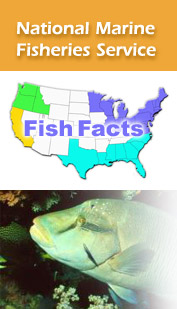 |
Welcome to NOAA's National Marine Fisheries Service (NOAA Fisheries Service). NOAA Fisheries Service is dedicated to the stewardship of living marine resources through science-based conservation and management, and the promotion of healthy ecosystems.
As a steward, NOAA Fisheries Service conserves, protects, and manages living marine resources in a way that ensures their continuation as functioning components of marine ecosystems, affords economic opportunities, and enhances the quality of life for the American public. |
|
 |
 |
| Features |
Hot Topics / Current Events |
 |
 |
 |
|
 Smithsonian's Ocean Hall Opens to Broad Acclaim Smithsonian's Ocean Hall Opens to Broad Acclaim
The Smithsonian Museum of Natural History recently unveiled the Sant Ocean Hall, offering visitors an exciting opportunity to learn about the planet's largest and most complex ecosystem, the ocean. This brand new 23,000 square foot exhibit contains seven galleries, featuring 674 marine specimens and models, a salt water coral tank, giant squid, and a life-size model of a North Atlantic right whale named Phoenix. NOAA Fisheries Service was instrumental in developing an interactive demonstration on science-based management of sustainable fisheries, and providing content for the Ocean Today kiosk, a multi-media video library. >> read more |
 NOAA Lists Cook Inlet Beluga Whales as Endangered NOAA Lists Cook Inlet Beluga Whales as Endangered
The Cook Inlet beluga whale population near Anchorage, Alaska is in danger of extinction, and NOAA Fisheries Service has listed it as an endangered species. “In spite of protections already in place, Cook Inlet beluga whales are not recovering,” said James Balsiger, acting assistant administrator for fisheries. Listing the Cook Inlet beluga whales means any federal agency that funds, authorizes, or carries out new projects or activities that may affect the whales in the area must first consult with NOAA Fisheries Service to determine the potential effects on the whales. A federal action must not jeopardize the continued existence of a listed species under the Endangered Species Act.. >> read more |
 MAFAC Appointments MAFAC Appointments
The Department of Commerce has appointed seven new members to the Marine Fisheries Advisory Committee (MAFAC). The agency has also reappointed four members for one additional year. MAFAC is the only federal advisory panel charged with advising the Secretary of Commerce on the Department’s living marine resource responsibilities. >> read more |
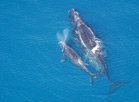 Ship Strike Reduction Rule Aims to Protect North Atlantic Right Whales Ship Strike Reduction Rule Aims to Protect North Atlantic Right Whales
NOAA officials have issued a regulation that will implement new measures to protect endangered North Atlantic right whales.
The regulation will, for the first time, require large ships to reduce speeds to ten knots in areas where the whales feed and reproduce.
“The ship strike rule, based on science, is a major addition to NOAA’s arsenal of protections for this endangered species," said Navy Vice Admiral Conrad C. Lautenbacher, Jr., under secretary of commerce for oceans and atmosphere and NOAA administrator. >> read more >> info on ship strike reduction |
 |
| Dr. Liz Brooks, a stock assessment scientist at NOAA, mentors undergraduates studying marine science. |
More Marine Scientists Needed: Report Forecasts Shortage
The federal departments of Commerce and Education are forecasting a serious shortage of scientists trained to do the high-quality research required to rebuild fish stocks and restore marine species in the next decade.
“At a time when the United States needs more scientists to provide the tools to rebuild valuable fish stocks and restore marine mammals and turtles, we are seeing a shortage of well-trained fishery scientists,” said retired Navy Vice Adm. Conrad C. Lautenbacher, Ph.D., under secretary of commerce for oceans and atmosphere and NOAA administrator. “We must work with universities and the private sector to convince young people to pursue careers in marine science.”
NOAA has several innovative recruiting programs, including fellowships, internships and mentoring programs. >> read more >> report and video |
 NOAA Fisheries Service Protects Bering Sea Habitat NOAA Fisheries Service Protects Bering Sea Habitat
NOAA Fisheries Service has prohibited the use of bottom trawl gear in 130,000 square
nautical miles of the Bering Sea, an area where the gear has not been used previously, to
protect the sea bottom habitat. The rule, recommended by the North Pacific Fishery Management Council,
protects large areas of sea bottom for the future, with minimal effect on today's fisheries. >> read more |
 NOAA Proposes Rule to Require Saltwater Angler Registration NOAA Proposes Rule to Require Saltwater Angler Registration
NOAA Fisheries Service is seeking comment on a proposed rule that requires anglers and spearfishers who fish recreationally in federal ocean waters to be registered before fishing in 2009. The proposed rule is part of a larger initiative to improve the quality and accuracy of data on marine recreational fishing and catches. The registry will also help measure the economic benefits of recreational fishing on the national and local economies. >> read more >> Marine Recreational Information Program |
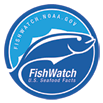 NOAA Develops Seafood Consumer Guide NOAA Develops Seafood Consumer Guide
Seafood consumers in the United States, increasingly concerned about the sustainability and quality of seafood, can now turn to a NOAA Fisheries Service Web site, FishWatch, for the latest information. This consumer guide provides the best available scientific information on over 60 of the most popular types of seafood. More species will be added to the site in the near future.
|
| WARNING: |
|
Consult IUU Fishing Lists Before Making Commercial Arrangements |
Illegal, unreported, or unregulated (IUU) vessel lists have been created by Regional Fishery Management Organizations to combat IUU fishing practices. Certain penalties may apply to vessels included on such lists; therefore, it is advisable to consult these lists before making commercial arrangements with listed vessels. Penalties may include restricted port access or unloading prohibitions. Some lists are intended to include only fishing vessels, some can include transport vessels as well. For more information: >> read more |
|
>> More Announcements
|
|
|
 |
| FishNews |
News Briefs |
 |
 |
 |
|
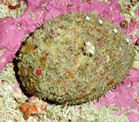 NOAA Completes White Abalone Recovery Plan NOAA Completes White Abalone Recovery Plan
NOAA’s Fisheries Service has made available the final recovery plan for white abalone, a marine mollusk listed in 2001 as endangered under the Endangered Species Act (ESA). This recovery plan outlines reasonable actions which are believed to be required to recover and/or protect white abalone, and is required by the ESA as a guideline for the conservation and survival of ESA listed species. The primary goal of this recovery plan is to establish self-sustaining populations of white abalone in a number of locations throughout its historic range.
>> read more |
 Federal Agencies to Propose Expanding Gulf of Maine Atlantic Salmon Population Protected by Endangered Species Listing Federal Agencies to Propose Expanding Gulf of Maine Atlantic Salmon Population Protected by Endangered Species Listing
NOAA Fisheries Service and the U.S. Fish and Wildlife Service have announced a proposal to redefine the endangered Gulf of Maine population of Atlantic salmon to include fish found in nearby areas. The proposal would expand the endangered designation to consist of Atlantic salmon populations from the Androscoggin River to the Dennys River, including anadromous salmon inhabiting the Kennebec and Penobscot rivers, as well as hatchery fish used in the recovery effort. >> read more
|
 Scientists Use Naval Exercises to Learn More About
How Marine Mammals React to Sonar
NOAA’s Fisheries Service, in partnership with top international scientists and the U.S. Navy, has just completed a pioneering research effort in Hawaii to measure the biology and behavior of some of the most poorly understood whales on Earth. During the study, for the first time, scientists attached listening and movement sensors on marine mammals around realistic military operations. >> read more Scientists Use Naval Exercises to Learn More About
How Marine Mammals React to Sonar
NOAA’s Fisheries Service, in partnership with top international scientists and the U.S. Navy, has just completed a pioneering research effort in Hawaii to measure the biology and behavior of some of the most poorly understood whales on Earth. During the study, for the first time, scientists attached listening and movement sensors on marine mammals around realistic military operations. >> read more
|
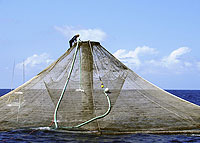 Report: Offshore Aquaculture Would Benefit U.S. Economy Report: Offshore Aquaculture Would Benefit U.S. Economy
Aquaculture shows significant economic potential and good prospects for success in the United States, according to a new report commissioned by NOAA. The report’s authors call for clear rules to be enacted to guide the development of an offshore aquaculture industry. >> read more
|
 Dam Removed with a Bang Dam Removed with a Bang
On October 1, NOAA and its partners removed the Whites Gulch Dam using powerful explosives, and the removal was captured on video. The video is now available online. The Whites Gulch River was once home to such a large population of salmon that citizens claimed they could walk across the river on their backs. But in the late 1800s, a dam was built on the river that blocked salmon from reaching their upstream spawning habitat, and populations are dwindling. The removal of this and another nearby dam, in combination with the removal of a barrier downstream later this year, will open up 1.5 miles of spawning and rearing habitat for spring Chinook salmon and threatened coho salmon and steelhead trout. The project will provide benefits to native riverine fish and wildlife, and improve safety for nearby communities. >> read more >> video of dam removal |
 NOAA Training Workshops for Seafood Dealers and Fishermen NOAA Training Workshops for Seafood Dealers and Fishermen
Free workshops are planned to assist Atlantic shark dealers with the identification of various shark species. Accurate species identification is important because some regulations vary by species; some stocks are severely overfished, while others are more plentiful. Atlantic shark dealers are required to attend the shark identification workshops in order to maintain valid Federal permits. In addition, special workshops for commercial fishermen who use bottom longline, pelagic longline, or gillnet gear will help them learn new techniques for releasing any protected species (e.g. sea turtles) that are caught accidentally. These "safe handling" workshops are required for fishermen who wish to maintain Federal swordfish and shark fishing permits.
>> read more |
|
>> Visit the News Room
|
|
|

|
|
 |
|





